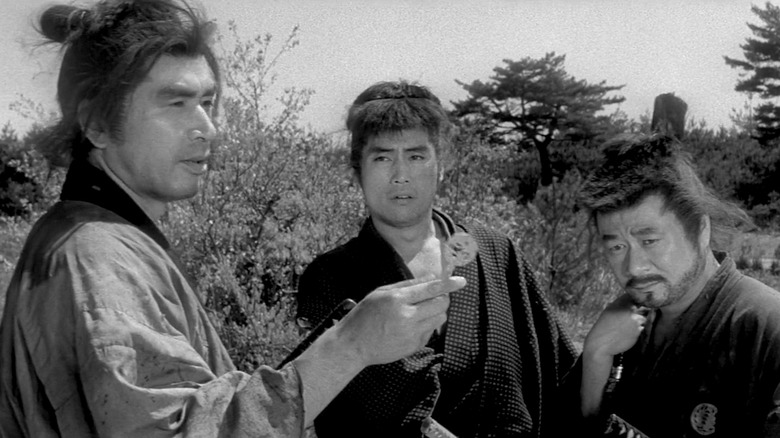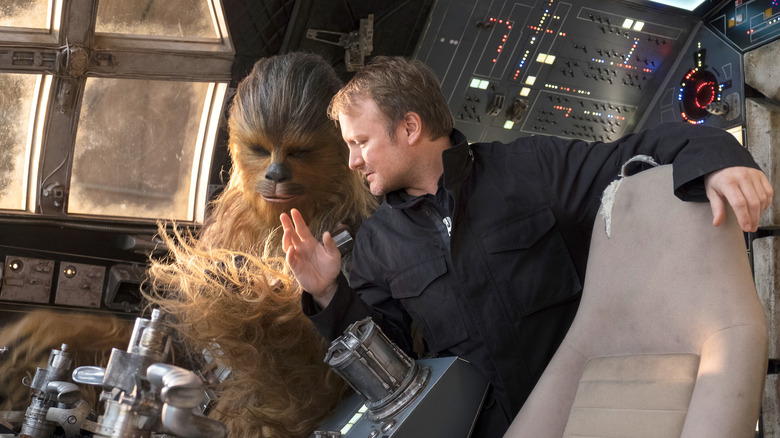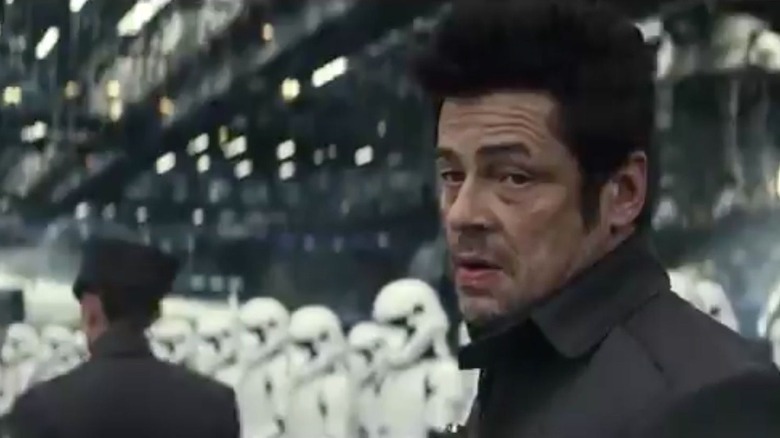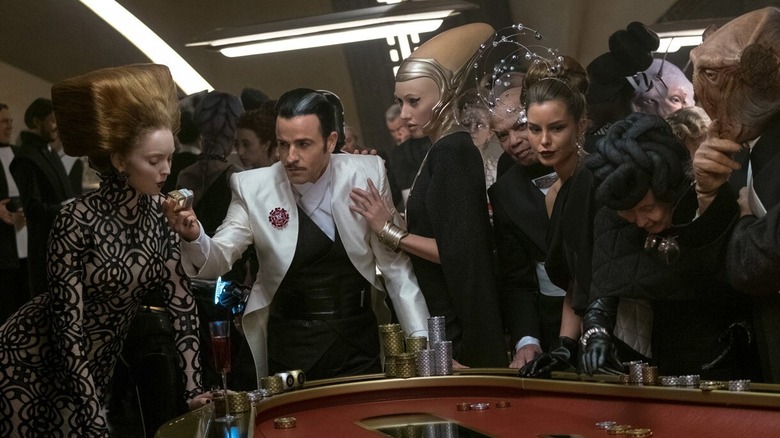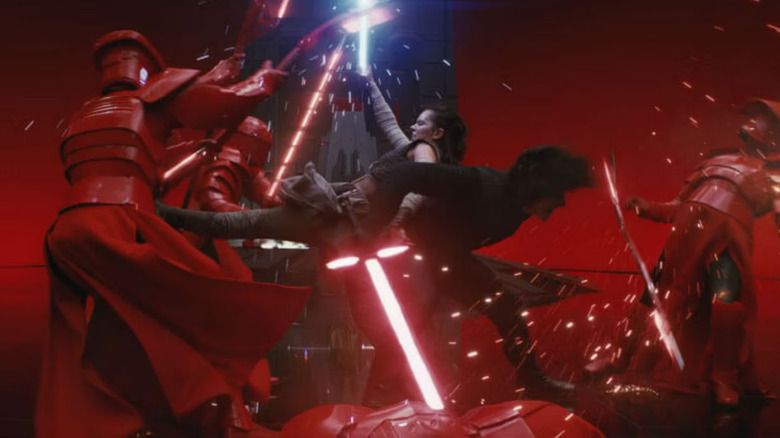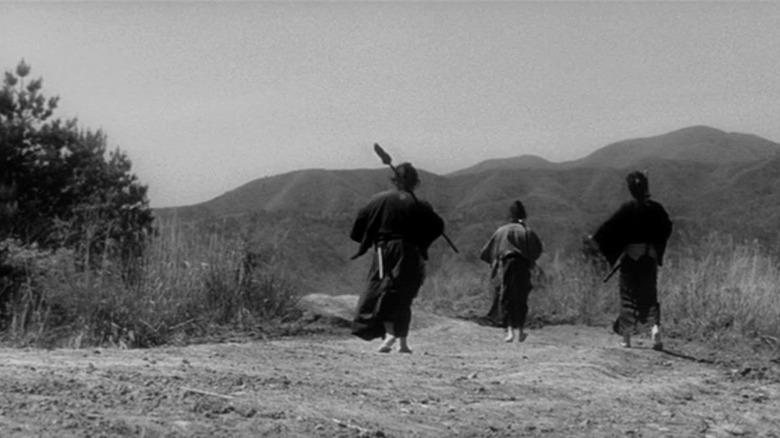The Japanese Classic That Influenced The Most Misunderstood Storyline In Star Wars: The Last Jedi
(Welcome to The Movies That Made "Star Wars," a series where we explore the films and television properties that inspired George Lucas' iconic universe. In this edition: The classic jidaigeki film "Three Outlaw Samurai.")
As the first feature film from the legendary Japanese filmmaker Hideo Gosha, "Three Outlaw Samurai," holds a special place in the pantheon of Japanese films. It tells the story of three samurai who battle corruption and balance their honor and obedience to the system that produced them with doing what's actually right — something that feels almost radical in this style of filmmaking. The movie's stars — Tetsurô Tanba, Isamu Nagato, and Mikijirô Hira as the titular samurai — were reprising their roles from a television show with the same name that had started the year before. According to the essay by Bilge Eberi that accompanies the Criterion Collection's excellent Blu-ray transfer of the film, the original show seems lost to time. It's to our great fortune, however, that we still have the movie.
The antagonist in the film is a dishonorable magistrate doing his best to cling to power and prevent the peasants in the area from petitioning the high lord who will soon come through town. He continues betraying everyone, paying one person to kill another until everything gets completely out of control and the three outlaw samurai, who were all on different sides at the outset of the film, unite to undo him and wander off into the haze together. As a new trio in partnership, it's heavily implied that they'll head off to become the "A-Team" for peasants across Japan. Based on descriptions, that's pretty much the premise of the television show that ran for six seasons.
Rian Johnson and The Last Jedi
Back on the press tour for "Star Wars: The Last Jedi," director Rian Johnson cited several influences for his movie. /Film has written about some of these influences — such as "Rashomon" to "Brazil" — previously, including how understanding what inspired Johnson helps inform a viewing of "The Last Jedi." In 2017, Johnson also shared with Empire Magazine three other films he screened in advance of writing and directing his "Star Wars" blockbuster. Those three movies were "Twelve O'Clock High," Alfred Hitchcock's "To Catch a Thief," and "Three Outlaw Samurai."
Initially, Johnson cites "Three Outlaw Samurai" as influencing the tone and fighting style he created in "Last Jedi," but there is so much more the movie offers in its inspiration for the "Star Wars" film. Hideo Gosha's movie is also worth watching on its own for the fun of it, but as a key piece of DNA to one of the best "Star Wars" films ever made, it's a revelation.
Jailed betrayal in both films
One of my favorite moments in "Three Outlaw Samurai" occurs when the magistrate is looking for expendable mercenaries to go deal with a problem he has. In his jail, the magistrate's men are holding a shabby samurai named Sakuro. They test him to see if he's actually a samurai and when he passes the test, they hire him to go attack the first outlaw samurai and the peasants he's protecting who have kidnapped the magistrate's daughter in an attempt to have their appeal heard.
When Sakura goes to confront the samurai and peasants, he hears their plight and instantly switches sides, turning on the magistrate and joining the forces of good.
This entire subplot echoes (albeit with far worse consequences) the situation with DJ on Canto Bight, when Maz Kanata tells Finn and Poe that there's only one Slicer she trusts that can do the job, and that's the Master Codebreaker. Realizing DJ might be their only possibility, Finn and Rose hire him to do the job if they can get out. They all get out of prison, just like Sakura in "Three Outlaw Samurai." And when push comes to shove and DJ is given a choice, he turns against his original employers and changes the trajectory of the story by turning Finn and Rose over to the Empire. Johnson cleverly uses this device near the climax, rather than the beginning as a setup, but watching Gosha use it here is nothing short of delightful.
The tone of The Last Jedi
Rian Johnson looked to "Three Outlaw Samurai" for its approach to pulpy fun, and you can see that on full display in the Canto Bight sequences (and throughout the rest of the film) of "The Last Jedi." Gosha is able to veer between silly and serious with aplomb, and Johnson captures that same vibe. There's an absurdity to all of it, because at the end of the day, "Star Wars" and "Three Outlaw Samurai" are pulpy fantasy stories and Johnson wisely draws that pulp fun into the intricate web of themes he's weaving in his big budget "Star Wars" film.
In "Three Outlaw Samurai," the magistrate abandons his honor to protect himself and tosses the peasants under the proverbial bus to do it — that encapsulates the entire tone of the Canto Bight sequences in "The Last Jedi." The rich will do anything to stay rich and exploit those lower than themselves. Those screaming that Johnson was injecting modern-day politics into "Star Wars" failed to realize two things: First, modern-day politics have always been a part of "Star Wars"; second, that the struggle from the lower classes against the wealthy is hundreds of years old. As much as we'd like to assume this is just a modern-day problem, the French Revolution and the Meiji Restoration both happened for a reason.
By incorporating a playful tone into his movie, Johnson creates a satisfying look at this ancient struggle against wealth and war and brings something that adds indelibly to the story and its themes.
The fights
The other major influence Rian Johnson took from "Three Outlaw Samurai" came from the sword-fighting. Hideo Gosha's film has an energetic style of swordplay that feels chaotic but well choreographed, and it plays right into the strengths of the throne room scene in "The Last Jedi" — one of the greatest action sequences in any "Star Wars" movie. Johnson pairs the exciting fights with excellent character work, but borrows some of the moves and camera and sword choreography from "Three Outlaw Samurai." In fact, there's a moment in the Japanese film where two of the samurai toss and receive a katana to continue a move in the fight, just like the moments in the throne room where Rey tosses her lightsaber to Kylo Ren.
This dynamism —combining character work, loose cinematography, and chaotic fight choreography into a visual ballet — is something Gosha did masterfully, and it was through Johnson's hard work that he was able to translate those techniques into something that would fit neatly in a galaxy far, far away.
Subversive filmmaking
"Three Outlaw Samurai" has a kinetic energy to it that makes it a whole lot of fun, but it's thematically dense in ways that subvert the classic ideals that are often presented in samurai stories. There's a subversion of the common tropes that Hideo Gosha feels at home with that Rian Johnson brought to the table with "The Last Jedi." In most samurai movies, loyalty and obedience are what bring a samurai honor, but the samurai who gain honor in this movie are the ones who do the betraying and disobeying, turning our classic understandings of samurai on their ear so that we can see what is truly good in the world we're privy to. Johnson does the same thing with Luke Skywalker — we think of Jedi as bold generals going off to fight, but it's the contemplative, monastic life that is more suited to the Jedi, especially if they want to break the cycles of violence. Luke's turn to non-violence takes our ideas of what Jedi are and transforms them into a blend of what we hope them to be and what they should be, just as Gosha does.
Gosha's "Three Outlaw Samurai" is a tight 95 minutes long and packs a lot of character into its perfect length. Watching it will not only give you insight into one of Johnson's influences for "The Last Jedi," but will also make you a wiser, more informed, and worldly connoisseur of fine films and even finer "Star Wars."
